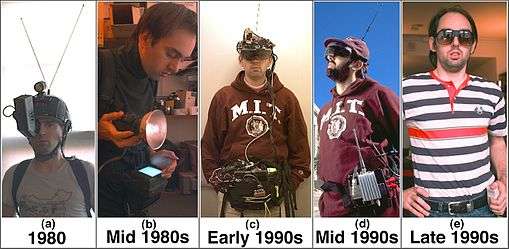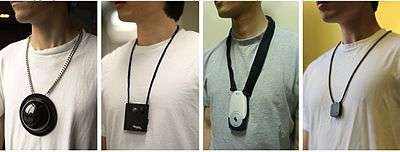Lifelog


A lifelog is a detailed chronicle of a person's life involving large amounts of data. In recent years the data is usually captured automatically by wearable technology or mobile devices. People who keep lifelogs about themselves are known as lifeloggers (or sometimes lifebloggers or lifegloggers).
Examples
Perhaps the first, and probably the most extreme, lifelogger was Robert Shields, who manually recorded 25 years of his life from 1972 to 1997 at 5-minute intervals. The resulting 37-million word diary is thought to be the longest ever written.
Perhaps the first person to capture continuous physiological data together with live first-person video from a wearable camera, was Steve Mann whose experiments with wearable computing and streaming video in the early 1980s led to Wearable Wireless Webcam. Starting in 1994, Mann continuously transmitted his everyday life 24 hours a day, 7 days a week, and his site grew in popularity, becoming Cool Site of the Day on February 17, 1995.[2] Using a wearable camera and wearable display, he invited others to both see what he was looking at, over the Web, as well as send him live feeds or messages in real time.[3] In 1998 Mann started a community of lifeloggers (also known as lifebloggers or lifegloggers) which has grown to more than 20,000 members.[4] Throughout the 1990s Mann presented this work to the U.S. Army, with two visits to US Natick Army Research Labs, as well as a formal invited talk.
Jennifer Ringley's JenniCam (1996–2003) was followed by collegeboyslive.tv (still running/NSFW)(1998–present).[5] That same year, the streaming of live video from the University of Toronto became a social networking phenomenon.[6]
Lisa Batey and HereAndNow.net started streaming 24/7 in 1999, continuing into 2001. "We Live In Public"[7] was a 24/7 Internet conceptual art experiment created by Josh Harris in December 1999. With a format similar to TV's Big Brother, Harris placed tapped telephones, microphones and 32 robotic cameras in the home he shared with his girlfriend, Tanya Corrin. Viewers talked to Harris and Corrin in the site's chatroom. Others on camera included New York artists Alex Arcadia and Alfredo Martinez, as well as =JUDGECAL= and Shannon from pseudo.com fame. Harris recently launched the online live video platform, Operator 11.[8]
DotComGuy arrived in 2000, and the following year, the Seeing-Eye-People Project[9] combined live streaming with social networking to assist the visually challenged. After Joi Ito's Moblog (2002), web publishing from a mobile device,[10] came Gordon Bell's MyLifeBits (2004), an experiment in digital storage of a person's lifetime, including full-text search, text/audio annotations and hyperlinks.[11] Social networking took a quantum leap in 2006 with live webcam feeds on Stickam.
In 2004, conceptual media artist Alberto Frigo began tracking everything his right (dominant) hand has used,[12] then began adding different tracking and documentation projects. His tracking is done manually rather than using technology.
In 2004 Arin Crumley and Susan Buice met online and began a relationship. They decided to forgo verbal communication during the initial courtship and instead spoke to each other via written notes, sketches, video clips and Myspace. They went on to create an autobiographical film about it called Four Eyed Monsters. It was part documentary, part narrative with a few scripted elements added. "[13] They went on to produce 13 podcasts about the making of the film in order to promote it.
In 2007 Justin Kan arrived wearing a webcam attached to a cap, Kan began streaming continuous live video and audio, beginning at midnight March 19, 2007, and he named this procedure "lifecasting".
The sub-filed of computer vision that processes and analyses visual data captured by a wearable camera is called Egocentric vision.
Recent years with the advent of smartphones and other pervasive devices the paradigm of life logging extended to ubiquitous devices. For instance UbiqLog[14] and Experience Explorer[15] employ mobile sensing to perform life logging. While other lifelogging devices, like the Autographer, use a combination of visual sensors and GPS tracking to simultaneously document where you are and what you see.[16] Lifelogging was popularized by mobile app Foursquare, which had users check-in as a way of sharing and saving their location, and later evolved into the popular lifelogging app, Swarm.
Life caching
Life caching refers to a social act of storing and sharing one's life events in an open and public forum.[17][18][19][20][21] Modern life caching is considered a form of social networking and typically takes place on the internet. The term was introduced in 2005 by trendwatching.com,[22] in a report that says that it had yet to occur but could potentially due to available technology. However, life log information is privacy sensitive, and sharing such information is associated with different risks.[23]
Mobile and wearable apps
To assist in their efforts of tracking, some lifeloggers use mobile devices and apps. Utilizing the GPS and motion processors of digital devices enables lifelogging apps to easily record metadata related to daily activities. A myriad of lifelogging apps are available in the App Store (iOS), Google Play and other app distribution platforms, but some commonly cited apps include: Instant[24], Reporter,[25] Journey,[26] Path,[27] Moves,[28] and HeyDay.,[29] insight for Wear (smartwatch)[30]
Xperia has also a native mobile application which is called Lifelog.[31] The app works standalone, but gets enriched when used with Sony Smart Bands.[32]
Swarm is a lifelogging app that motivates users to check-in and hold on to every place they’ve visited, while inspiring them to visit new places.
See also
References
- ↑ IEEE Computer, pp. 25-32, Vol. 30, Iss. 2 Feb. 1997
- ↑ Cool Site of the Day, Feb 17, 1995
- ↑ [ Wearable Wireless Webcam]
- ↑ [ The Glogger community]
- ↑ [ collegeboyslive.tv]
- ↑ [ Cyborgs Broadcast Orientation Worldwide]
- ↑ [ Platt, Charles. "Steaming video," Wired, November 2000]
- ↑ [ Naone, Erica. "The Rise of the Net Jockey", Technology Review, August 10, 2007.]
- ↑ [ Seeing-Eye-People Project]
- ↑ [ Moblog]
- ↑ [ MyLifeBits Project]
- ↑ Bruce Sterling (April 9, 2006). "Alberto Frigo". Wired Magazine.
- ↑ [ this might be a Love story by Stephanie Gerson on smartmobs.com]
- ↑ "UbiqLog: a generic mobile phone-based life-log framework". Springer.
- ↑ "Experience Explorer: A Life-Logging Platform Based on Mobile Context Collection". IEEE.
- ↑ "Autographer Life Logging Wearable Camera Review". 2014.
- ↑ Schofield, Jack (August 18, 2004). "How to save your life". The Guardian. London.
- ↑ Schofield, Jack (February 21, 2007). "Life caching revisited -- Gordon Bell's digital life". The Guardian. London.
- ↑ Beaumont, Lucy (July 18, 2004). "Life in byte-sized pieces". The Age. Melbourne.
- ↑ "The trend-spotters handbook". The New Zealand Herald. October 17, 2005. Retrieved October 14, 2011.
- ↑ "Ethics on the line as ordinary people put themselves in the picture". The Sydney Morning Herald. August 1, 2006.
- ↑ http://trendwatching.com/trends/LIFE_CACHING.htm
- ↑ "Towards sharing life-log information with society". 2012.
- ↑ "5 Lifelogging apps for 2018: Keep track of your year". Emberify Blog. 2016-01-14. Retrieved 2018-01-18.
- ↑ Ellis Hamburger (February 6, 2014). "Reporter for iPhone tracks your whole life, one quiz at a time". The Verge.
- ↑ Eric Ravenscraft (January 14, 2016). "Journey Is a Journal App With Photo Support and Calendar View". Lifehacker.
- ↑ Nate Swanner (July 9, 2014). "These three iOS apps make life-logging fun and easy". Slash Gear.
- ↑ Dani Fankhauser (September 24, 2013). "9 Lifelogging Apps to Log Personal Data". Mashable.
- ↑ "Lifelogging / Quantified Self". Lifestream Blog.
- ↑ "Lifelogging tool for Android Smartwatch".
- ↑ "Lifelog – innovative activity tracker Android™ app from Sony". Retrieved 10 Oct 2015.
- ↑ "Sony SmartBand 2". Retrieved 10 Oct 2015.
Bibliography
- Kieron, O’Hara; Tuffield, Mischa M.; Shadbolt, Nigel (2009). "Lifelogging: Privacy and empowerment with memories for life". Identity in the Information Society. Springer. 1 (1): 155. doi:10.1007/s12394-009-0008-4